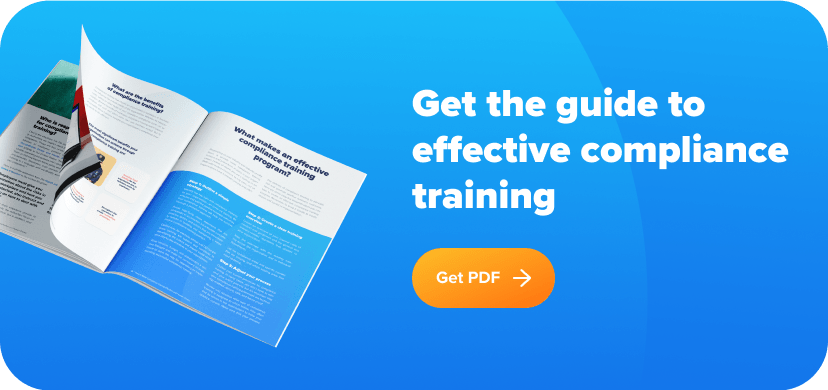Why it matters: Without proper training, you could misclassify your employees, leading to costly fines and litigation.
There’s a lot of confusion around the exempt and nonexempt classifications for employees under the Fair Labor Standards Act (FLSA). This article is designed to help HR and payroll professionals understand the rules so they can properly classify their employees.
We’ll start by describing the distinctions between exempt and nonexempt employees, then we’ll go over some common myths about FLSA classification. Finally, we’ll give you a few tips on how to stay compliant with FLSA regulations.

The Difference Between Exempt and Nonexempt Employees
The Fair Labor Standards Act (FLSA) is a federal law that establishes minimum wage, overtime pay, record keeping, and child labor standards affecting full-time and part-time workers in the private sector and in federal, state, and local governments. The FLSA classification of exempt vs. nonexempt employee status is important because it determines which employees are eligible for overtime pay.
Exempt Employees
An exempt employee is an employee who is not subject to the minimum wage and overtime provisions of the FLSA. Exempt employees are typically executive, administrative, or professional employees, although there are a few other exempt categories, including computer professionals, outside sales employees, and highly paid workers who perform certain types of duties.
To qualify as exempt, employees must satisfy certain salary and duties tests set forth in the FLSA regulations. These tests are generally designed to assess whether an employee’s primary duty is executive, administrative, or professional in nature.
Nonexempt Employees
All employees who do not meet the FLSA’s exemption requirements are nonexempt employees. Nonexempt employees are entitled to minimum wage and overtime protections under the FLSA.
Nonexempt employees are entitled to wages for all hours worked, including overtime pay for any hours worked over 40 in a given week. They must also receive breaks during their shifts and be allowed to take leave when they need it. In general, nonexempt employees are entitled to all the protections and benefits of the FLSA.

How to Determine if an Employee is Exempt or Nonexempt
When trying to determine if an employee is exempt or nonexempt, job duties are usually the best place to start. The FLSA outlines several duties tests that can be used to make this determination. These include the administrative exemption test, the executive exemption test, the professional exemption test, and outside sales exemption test.
- The administrative exemption test applies to employees whose primary duty is performing non-manual work directly related to the management or general business operations of their employer or their employer’s customers.
- The executive exemption test applies to employees whose primary duty is managing an enterprise or subdivision thereof and who customarily and regularly direct the work of at least two other full-time employees.
- The professional exemption test applies to certain learned and creative professionals, as well as some computer professionals. This includes employees such as doctors, lawyers, engineers, architects, teachers, clergy members, accountants, registered nurses, and certain artists.
- The outside sales exemption applies to workers primarily engaged in sales. Be aware, however, there’s a requirement that the salesperson be engaged in sales outside of the workplace. This means an employee doing phone sales from home or in an office would not qualify.
Another factor that needs to be considered when determining if an employee is exempt or nonexempt is salary level. Currently, the minimum salary required for an employee to qualify for exemption status is $684 per week ($35,568 per year).
Besides meeting this salary level criterion, employers must also pay an exempt employee on a salary basis—meaning they receive their full salary for any week in which they perform any work without regard to the number of days or hours actually worked.
Compliance Tip: We strongly recommend that you conduct an annual review of every position. The FLSA occasionally updates the salary basis test, increasing the salary required to be an exempt employee. An employee’s duties may also shift over time, moving them in or out of an exempt role. Doing an annual audit of your employee classifications will ensure you stay on top of any law changes and you’re correctly classifying your employees.

Common Exempt Job Titles
- CEO
- CFO
- Doctor
- Lawyer
- Engineer
- Accountant
- Operations Director
- People Manager
- Database Manager
- Computer Systems Analyst
- Developer
Common Nonexempt Job Titles
- Accounts Payable/Receivable Clerk
- Administrative Assistant
- Bank Teller
- Bookkeeper
- Receptionist
- customer service representative
- Stock clerk
- Warehouse worker
- General office clerk
- Teacher aide
Classifying Employees for Payroll and HR Purposes
Besides the complex exempt versus nonexempt classification process—something you’ll dive deep into during the full training—you must ensure your employees are classified in two other key ways. Here’s a brief overview of these additional classifications.
Full-Time vs. Part-Time
The vast majority of employers use a full-time or part-time classification for their employees. Full-time employees are typically defined as those who work 40 hours or more per week. Part-time employees are typically those who work less than 40 hours per week. This classification is generally used for things like benefits eligibility and vacation accrual.
Be aware, however, that there are no federal requirements on what makes a full-time or part-time employee. Some states have specific requirements, so make sure you pay attention to your state laws. Generally speaking, however, your company can define how many hours an employee must work to be considered full-time. Any employee working on a regular basis less than the minimum hours you set is part-time.
Salaried vs. Hourly
Another common classification is salaried versus hourly. Salaried employees are typically those who are paid a set amount regardless of how many hours they work. Hourly employees are typically those who are paid based on the number of hours they work. This classification is generally used for things like overtime eligibility and pay rates.
It’s important to note here that many companies classify employees as salaried and exempt, assuming that anyone on salary is automatically an exempt employee. That’s not accurate. Employees can be paid a salary and still be entitled to overtime pay.

Common Myths About FLSA Classification
The FLSA affects nearly every employee in the United States, which is why it’s so important for HR professionals to have a good understanding of the law. Unfortunately, there are a lot of myths and misconceptions about the FLSA floating around out there. Here are four of the most common myths about FLSA classification.
Myth 1: All employees are automatically classified as nonexempt
The default classification for employees is nonexempt, but there are certain circumstances where an employee may be classified as exempt. For example, if an employee meets the salary basis and duties tests for executive, administrative, or professional exemption under the FLSA, they may be classified as exempt. This is why it’s crucial that you conduct a thorough review of every employee to ensure they’re correctly classified.
Myth 2: As long as employees are paid a salary, they’re automatically exempt
Just because an employee is paid a salary doesn’t mean they’re automatically exempt from overtime pay. There are other factors that come into play, such as whether the employee meets the salary basis and duties tests for exemption. You can’t simply pay a person a salary and assume they’re exempt.
Myth 3: Exempt employees don’t have to track their time worked
Although exempt employees are not eligible for overtime pay, they still need to track their time worked for other purposes. Some states require companies to provide employees with itemized paystubs, which include the total hours worked during the pay period, even for exempt employees. It’s also possible, though rare, that an exempt employee works so few hours that they actually become a part-time employee, losing access to benefits and gaining FLSA protections. If they’re not tracking their time, you’d never know.
Myth 4: Employees can waive their right to overtime pay
Employees cannot waive their right to overtime pay under the FLSA. If an employer attempts to get an employee to waive their right to overtime pay, they may be subject to penalties from the Department of Labor.

Your Next Steps to Ensure Compliance
So, what do you need to do? Make sure your HR and payroll teams are properly trained on the FLSA. That’s really the key here—getting everyone on board with understanding who is exempt and who is nonexempt.
There are a lot of myths out there about classification, but as long as you have the facts, you should be able to make the right decisions for your business. To help you, partner with a training platform does the hard work for you, so you can focus on your core business needs. With eloomi, we make sure your compliance training is up to date and contains accurate information to help guide and support your employees in their work.
Get in touch to see how you can take advantage of eloomi’s ready-made US Compliance training content and bring your teams up to speed.

About Bryan
A people leader veteran, Bryan is a writer and lawyer. He’s written for Yahoo!, Forbes, LegalZoom, and the ABA, among others. He’s appeared on podcasts to help companies and employees better understand each other. And he’s worked to assess company employment law compliance while ensuring an employee-centric focus.
Bryan knows HR legal compliance and people operations like the back of his hand and conducts training on the crucial topics because he wants everyone to have a basic understanding of how these complex (but essential) systems work—and so that employees feel heard and understood by their employers.






